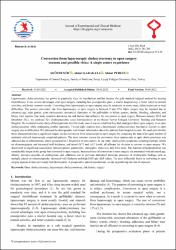| dc.contributor.author | Özdemir, Ali | |
| dc.contributor.author | Karakaya, Ahmet | |
| dc.contributor.author | Pergel, Ahmet | |
| dc.date.accessioned | 2022-12-29T08:31:25Z | |
| dc.date.available | 2022-12-29T08:31:25Z | |
| dc.date.issued | 2022 | en_US |
| dc.identifier.citation | Özdemir, A., Karakaya, A. & Pergel, A. (2022). Conversion from laparoscopic cholecystectomy to open surgery reasons and possible risks: A single center experience. Journal of Experimental and Clinical Medicine, 39(3), 781-785. http://doi.org/10.52142/omujecm.39.3.36 | en_US |
| dc.identifier.issn | 1309-4483 | |
| dc.identifier.uri | http://doi.org/10.52142/omujecm.39.3.36 | |
| dc.identifier.uri | https://hdl.handle.net/11436/7305 | |
| dc.description.abstract | Laparoscopic cholecystectomy has grown in popularity since its introduction and has become the gold standard surgical method for treating cholelithiasis. It has several advantages over open surgery, including less postoperative pain, a shorter hospital stay, a faster return to normal activities, and better cosmetic results. Converting from laparoscopic to open surgery may be necessary in some cases, either to prevent or treat difficulties. The current conversion rate from laparoscopic to open surgery is between 2 and 15%. Open surgery may be required due to advanced age, male gender, acute cholecystitis, anatomical alterations of the gallbladder or biliary system, obesity, bleeding, adhesions, and biliary tract injuries. Our study aimed to determine the risk factors that influence the conversion to open surgery. Between January 2018 and December 2021, we analyzed 921 cholecystectomy cases retrospectively at the Recep Tayyip Erdogan University Training and Research Hospital. We excluded twenty-three of these patients from the study once it was revealed that they had undergone direct open surgery or an open cholecystectomy while undergoing another operation. Twenty-eight patients had a laparoscopic cholecystectomy but had to convert to open surgery due to difficulties. We obtained the demographic and clinical information about the patients from hospital records. We analyzed whether these characteristics had a significant impact on the conversion from laparoscopic to open surgery by comparing the data of an equal number of randomly selected laparoscopic completed patients. The most common reason for conversion from laparoscopic to open cholecystectomy was adhesion due to inflammation, which accounted for 3.04 percent of conversions. In our study, cholecystitis symptoms, including multiple calculi on ultrasonography and increased wall thickness, and raised GGT and ALP levels, all affected the decision to convert to open surgery. We discovered no significant associations between gender, pancreatitis, cholangitis, stone size, and ASA score. The duration of hospitalization was considerably longer in the group that converted to open surgery. Increased rates of conversion to open surgery are associated with advanced age, obesity, previous episodes of cholecystitis, and adhesions due to previous abdominal incisions, presence of cholecystitis findings such as multiple calculi on ultrasonography, increased wall thickness and high GGT and ALP values. The most influential factor in converting to open surgery appears to have previously had cholecystitis. A preoperative patient examination can aid in predicting the risk of exposure. | en_US |
| dc.language.iso | eng | en_US |
| dc.publisher | Ondokuz Mayis Universitesi | en_US |
| dc.rights | info:eu-repo/semantics/openAccess | en_US |
| dc.subject | Laparoscopic cholecystectomy | en_US |
| dc.subject | Open cholecystectomy | en_US |
| dc.subject | Risk factors | en_US |
| dc.subject | Surgery | en_US |
| dc.title | Conversion from laparoscopic cholecystectomy to open surgery reasons and possible risks: A single center experience | en_US |
| dc.type | article | en_US |
| dc.contributor.department | RTEÜ, Tıp Fakültesi, Cerrahi Tıp Bilimleri Bölümü | en_US |
| dc.contributor.institutionauthor | Özdemir, Ali | |
| dc.contributor.institutionauthor | Karakaya, Ahmet | |
| dc.identifier.doi | 10.52142/omujecm.39.3.36 | en_US |
| dc.identifier.volume | 39 | en_US |
| dc.identifier.issue | 3 | en_US |
| dc.identifier.startpage | 781 | en_US |
| dc.identifier.endpage | 785 | en_US |
| dc.relation.journal | Journal of Experimental and Clinical Medicine (Turkey) | en_US |
| dc.relation.publicationcategory | Makale - Uluslararası Hakemli Dergi - Kurum Öğretim Elemanı | en_US |


















